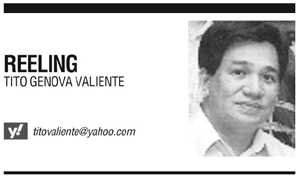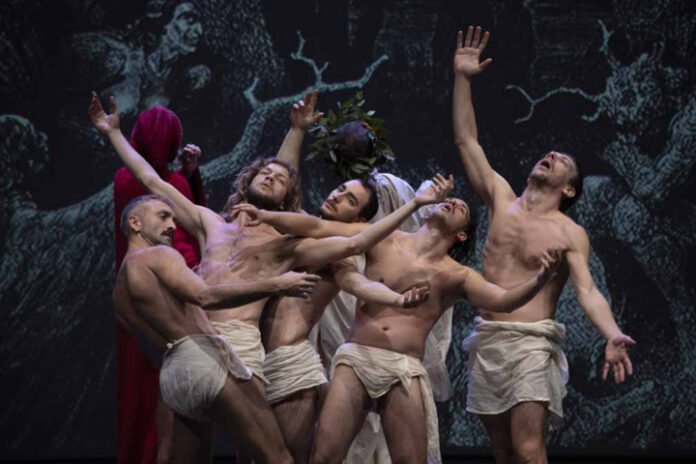
DIVINE Comedy begins with a book and ends with a book. And, in the 27-plus-minute short film of Massimiliano Finazzer Flory, Dante Per Nostra Fortuna/Dante, Our Luck, Dante Alighieri’s eternal masterpiece is introduced with a little boy reading a book, which turns out to be the commedia. In between is a dense, complex and complicated journey through love, truth, desire and back to love again. The film, in a way, reintroduced us to Purgatory, Hell and Paradise as no more sites of trespasses than tunnels through which we get to learn again the lessons about love. Through words and through bodies.
The words live in the text of the book; on film, bodies are the ones that tell the cantos of Inferno, Purgatorio and Paradiso. Half-naked figures writhe and contort in pairs, trios and choruses. They dance to a thundering beat of a music so primeval it begs the elegance of the written allegory.
As the dance continues, it is apparent what the filmmaker is trying to tell us: these are the souls as they cope with the geographies of Hell, Purgatory
and Heaven or enlightenment. Interestingly, these dances happen in bright lights, as if darkness is not necessary to induce terror. The sight of bodies eternally being punished to move is scary in themselves. Eternity, it seems, is the curse in Hell and the gift in Heaven.
Through the years, the students of literature or Big Books have known Dante’s Divine Comedy not only by reading it but by seeing the many illustrations honoring such a great work. For originating the illustration for the epic poem, Sandro Botticelli with his some 90 sketches and paintings comes to mind. Then there is Gustave Dore. In mid-1800s, he came up with the ambitious project of visualizing the lines of Dante. When the images came out, the readers saw such a kinship between the literature and the visual arts that there were rumors of Dore, a young man then, being in occult conversation with the poet of 14th century Italy.
One of the most monumentally horrifying illustrations done by Dore is this image of the Greyon, the Monster of Fraud, taking on its wings, Virgil and Dante, as they journey to the eighth level of Hell.
According to filmmaker Flory, the present-day value of Divine Comedy is in the universality of its message: “We all imagine through images hell and heaven. We all see Dante’s places beyond words, as if in front of us we had a screen that makes us live psychic mental projections, and this is cinema. Luckily for us, Dante wrote Divine Comedy like a compelling TV series from which we feel the flow of a story episode after episode. For ‘our luck’ it’s not just the title of a movie but the awareness that when a country has a poet among its founders, that country is universal.”
In my book, I like the idea of retribution as contrapasso. This to me is Dante’s brilliant contribution (outside of his massive contribution to the development of Italian language, following the experts on Italian literature): the punishment should reflect and/or refract the sin committed. For example, outside the gate of Hell is a vestibule where sinners who could not decide when they were alive kept going back and forth, uncertain of what they would do. There is also the punishment for the fortune tellers who are punished to walk with their back turned to where they are going, because on Earth they were always trying to foretell what would happen in the future or where people were going. Writers have a term for this—poetic justice.
There is the other universality of Dante’s Divine Comedy and we find it in the recognizable protagonists that inhabit the grand tale: Dante in his flowing robe, the face not revealed to the audience; his companion, Virgil, the laureled poet who represents knowledge; and Beatrice, Dante’s muse and beloved. Beatrice stands for enlightenment.
The screening of Dante Per Nostra Fortuna/Dante, Our Luck was made possible through the initiative of the Philippine-Italian Association (PIA), which was represented by Alessandro Milani, the Dante Alighieri Society in Manila (SDA), and the Italian Chamber of Commerce in the Philippines (ICCPI), under the auspices of the Embassy of Italy in the Philippines, collaborating with the Film Development Council of the Philippines (FDCP), the National Library of the Philippines (NLP), and other university partners. Included as one of the partners was the Ateneo de Naga through its university press.
This is not my first encounter with Massimiliano Finazzer Flory. In 2019, I wrote of his work: Being with da Vinci: The Impossible Interview. In that review, which appeared in this space on October 31, 2019, I spoke of the charm of the film as coming from the presentation of da Vinci in a matter-of-factly manner. He was not a phantom. He was a real man, manifesting himself because the world still had many questions to ask. Certainly, when he was alive, much as he was already great, the questions would have been different. But after hundreds of years, the questions and the doubts have accumulated regarding da Vinci—his intellect, his beliefs, his humanity.”
Directed by Massimiliano Finazzer Flory from his screenplay, the film utilized the original texts attributed to Leonardo da Vinci. They were taken from da Vinci’s journals and letters. The director also acted as Leonardo da Vinci.
Read full article on BusinessMirror

